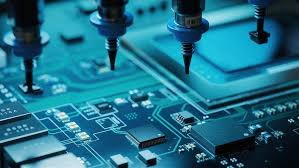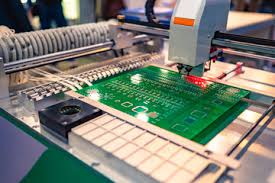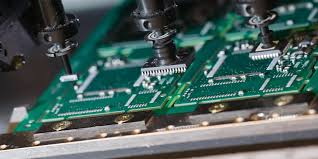Content Menu
● Understanding SMD Machines
>> Components of an SMD Machine
● Common Issues with SMD Machines
● Troubleshooting Steps
>> 1. Initial Inspection
>> 2. Check Power Supply
>> 3. Test Heating Element
>> 4. Examine Air Pump
>> 5. Verify Temperature Sensor
>> 6. Clean Nozzles and Filters
● Repair Techniques
>> Replacing Components
>> Resoldering Connections
>> Calibration
● Preventive Maintenance Tips
● Advanced Techniques in SMD Repair
>> Using a Digital Microscope
>> Employing Proper Soldering Techniques
● Common Problems During Soldering
>> Solder Bridging
>> Tombstoning
>> Insufficient Solder Joints
● Conclusion
● FAQ
>> 1. What should I do if my SMD machine does not heat up?
>> 2. How can I improve airflow in my SMD machine?
>> 3. What causes temperature fluctuations in my SMD machine?
>> 4. How often should I perform maintenance on my SMD machine?
>> 5. Can I repair my SMD machine myself?
● Citations:
Surface Mount Device (SMD) machines are essential tools in modern electronics manufacturing, used for soldering and desoldering components on printed circuit boards (PCBs). However, like any machinery, they can encounter issues that necessitate repair. This article provides a comprehensive guide on how to diagnose and repair SMD machines, focusing on common problems, troubleshooting techniques, and maintenance tips.

Understanding SMD Machines
SMD machines, commonly referred to as SMD rework stations or hot air soldering stations, utilize heated air to melt solder and facilitate the attachment or detachment of electronic components. They are particularly useful for working with delicate components such as integrated circuits (ICs) and Ball Grid Arrays (BGAs).
Components of an SMD Machine
- Hot Air Gun: This is the primary tool that emits hot air to melt solder.
- Temperature Control: Allows the operator to set the desired temperature for soldering.
- Airflow Control: Regulates the speed and volume of hot air being expelled.
- Nozzles: Different sizes and shapes are available for various applications.
- PCB Holder: Stabilizes the PCB during soldering or desoldering processes.
- Digital Microscope: Aids in precise placement and inspection of tiny components.
Common Issues with SMD Machines
SMD machines can face several common issues that affect their performance. Understanding these problems is the first step in effective repair.
- No Hot Air Output: Often caused by a malfunctioning pump or heating element.
- Temperature Fluctuations: Can result from faulty temperature sensors or poor calibration.
- Inconsistent Airflow: May be due to blockages in the nozzle or issues with the airflow control system.
- Electrical Failures: Problems with internal wiring or connections can lead to complete machine failure.
Troubleshooting Steps
When faced with a malfunctioning SMD machine, follow these troubleshooting steps:
1. Initial Inspection
Start with a visual inspection of the machine. Look for:
- Loose connections
- Burnt components
- Signs of overheating
2. Check Power Supply
Ensure that the machine is properly plugged in and that the power supply is functioning. Use a multimeter to test voltage levels at the input.
3. Test Heating Element
If no hot air is being produced, check the heating element:
- Disconnect it from the machine.
- Use a multimeter to measure resistance; it should show continuity if functional.
- If it shows an open circuit, replace the heating element.
4. Examine Air Pump
For machines with no airflow:
- Inspect the air pump for blockages or damage.
- Check electrical connections to ensure power is reaching the pump.
- If necessary, replace the pump.
5. Verify Temperature Sensor
Temperature fluctuations can often be attributed to faulty sensors:
- Test the sensor's resistance at different temperatures.
- Replace if readings are inconsistent or out of range.
6. Clean Nozzles and Filters
Ensure that nozzles are free from obstructions:
- Remove any debris or solder residue.
- Clean filters as needed to maintain optimal airflow.
Repair Techniques
Once you have identified the issue, you can proceed with repairs using appropriate techniques.
Replacing Components
For faulty components such as heating elements or sensors:
1. Disconnect power and discharge any capacitors.
2. Remove damaged components carefully using desoldering techniques.
3. Install new components and ensure all connections are secure.
Resoldering Connections
If you find loose or broken solder joints:
1. Heat the joint with your hot air tool until the solder melts.
2. Add fresh solder as needed and allow it to cool.

Calibration
After repairs, recalibrate your machine:
1. Set it to a known temperature using a thermocouple for accuracy.
2. Adjust airflow settings based on component specifications.
Preventive Maintenance Tips
To avoid future issues with your SMD machine, consider these maintenance tips:
- Regular Cleaning: Keep nozzles and filters clean to prevent blockages.
- Routine Inspections: Periodically check electrical connections and components for wear.
- Proper Storage: Store your machine in a dry environment to prevent corrosion.
Advanced Techniques in SMD Repair
In addition to basic repairs, understanding advanced techniques can enhance your ability to work with SMD machines effectively.
Using a Digital Microscope
A digital microscope can significantly improve precision when working with tiny components. It allows you to see details that are otherwise invisible to the naked eye, ensuring accurate placement and inspection of SMD parts.
Employing Proper Soldering Techniques
When working with SMD components, it's crucial to use proper soldering techniques:
1. Apply Flux: Always apply flux before soldering; this helps improve solder flow and adhesion.
2. Use Appropriate Nozzles: Select nozzle sizes based on component size; smaller nozzles are ideal for tiny parts while larger nozzles suit bigger components.
3. Maintain Movement: When using a hot air tool, keep it moving in circular motions rather than concentrating heat in one spot to avoid damaging components or pads.
4. Check Connections: After soldering, use a multimeter to check for continuity and ensure there are no short circuits.
5. Clean Up: After completing your work, clean your PCB using PCB cleaning liquid to remove any residual flux or debris.
Common Problems During Soldering
Understanding common problems during soldering can help you troubleshoot effectively:
Solder Bridging
This occurs when excess solder connects two pads unintentionally, leading to shorts. To avoid this:
- Use an appropriate amount of solder paste during assembly.
- Inspect your work under magnification before powering up your device.
Tombstoning
A phenomenon where one side of a component lifts off its pad during reflow due to uneven heating. To mitigate this risk:
- Ensure even heat distribution by adjusting airflow settings on your hot air station.
Insufficient Solder Joints
This problem arises when there isn't enough solder applied during assembly, leading to weak connections. To prevent this:
- Make sure your stencil design matches pad dimensions correctly when applying solder paste.
Conclusion
Repairing an SMD machine requires a systematic approach involving diagnosis, component replacement, advanced techniques, and routine maintenance. By understanding common issues and employing effective troubleshooting techniques, you can extend the lifespan of your equipment and ensure optimal performance in your electronic projects. Regular maintenance not only prevents future problems but also enhances efficiency during operations.

FAQ
1. What should I do if my SMD machine does not heat up?
Check the power supply first; if it's functioning, inspect the heating element for continuity using a multimeter. If there's no continuity, you'll need to replace it.
2. How can I improve airflow in my SMD machine?
Ensure that all nozzles are clean and free from obstructions. Additionally, check that the air pump is functioning correctly without any blockages.
3. What causes temperature fluctuations in my SMD machine?
Temperature fluctuations can occur due to faulty temperature sensors or incorrect calibration settings. Testing and replacing sensors may be necessary.
4. How often should I perform maintenance on my SMD machine?
Regular maintenance should be performed every few months or more frequently if you use your machine heavily. This includes cleaning nozzles and checking connections.
5. Can I repair my SMD machine myself?
Yes, many repairs can be done at home with basic tools like a multimeter and soldering equipment. However, for complex issues, seeking professional help may be advisable.
Citations:
[1] https://www.electroniclinic.com/smd-soldering-tutorial-for-beginners-tips-tricks-smd-rework-station/
[2] https://www.youtube.com/watch?v=CORLzDxDV4w
[3] https://jhdpcb.com/blog/efficient-smt-assembly/
[4] https://www.zjyingxing.com/info/what-are-the-cleaning-and-maintenance-methods-82799641.html
[5] https://www.aixuntech.com/newsinfo/smd-rework-station-comprehensive-guide-for-beginner/
[6] https://www.zjyingxing.com/info/what-are-the-common-smt-pick-and-place-machine-88387624.html
[7] https://www.rayprasad.com/repair-and-rework-requirements-for-smt-assemblies
[8] https://www.gordakelec.com/news/care-and-maintenance-for-soldering-and-rework-station-system.html
[9] https://www.vse.com/blog/2022/03/15/8-common-smt-placement-issues-and-solutions/
[10] https://www.aixuntech.com/newsinfo/how-to-maintain-a-hot-air-station/




















